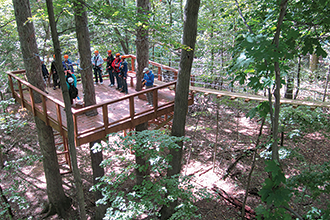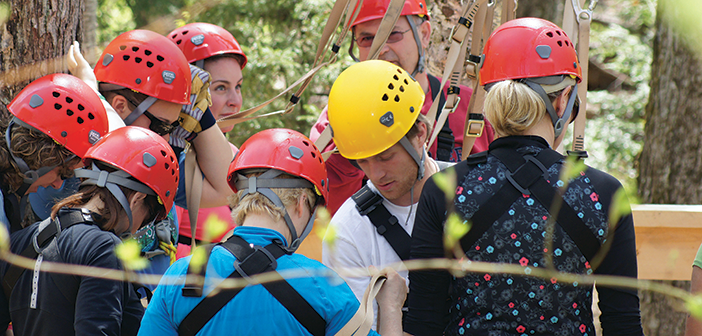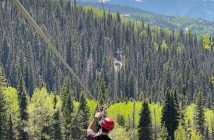“The idea is for people to know what they are getting into while still challenging themselves. We tell them to do as much as they feel they can do, but at the same time to respect their abilities,” Johnson says.
Following the verbal presentation and the gear check, guests proceed to a demonstration area where they participate in a demo course a few feet off the ground. The demo includes four basic elements—typically, a zip line position, an action or moving element, a ladder (including how to climb the ladder in the proper fashion), and a balancing or fixed element. Guides go through the demo course first, explaining each element, while guests watch. Then the guides watch, coach, and correct guests as they take their turns.
Adirondack Extreme has two demo courses—one for 7- to 11-year-olds, who generally need more attention, and the other for ages 12 and above. With two courses, guests can move through the demo at their own pace.
“If someone makes a mistake in the demonstration area, we make them go through the full demo again, so they understand and appreciate it. They aren’t embarrassed. They enjoy the experience.
“Only when the rescue guide sees that they understand every element are they free to start the course,” says Johnson.
Depending on what equipment is used in the park, guests also get tutorials on how to use the belay system and zip line trolley. “Whether the park uses a lobster claw carabiner or a new smart belay, we spend a great deal of time on safety,” Johnson says. “It’s a fallacy that you don’t have to spend a lot of time if you have a smart belay system.” It’s all disorientingly new, remember.
In addition, guests are coached on how to clip in, and instructed to yell back at the end of a zip line (especially longer lines in which the end point is not visible from the start) to let others know when it’s clear to go. They are advised on what to do in a transition area, and to let faster groups pass by. “Especially in seasonal climates, you want to maximize your throughput in those summer months,” Johnson advises.
Last but not least, if guests need assistance, they are instructed to yell, “Guide! Guide! Guide!”
Zip Lines
For zip lines and tours, the depth of the instruction depends on the type of course, says Pingle, who has co-owned ZipZone Canopy Tours in Ohio with Jerrod since 2012, as well as run Get a Grip Adventures since 2004. With all their years of experience, the Pingles have developed a body of specific advice.
On tours that have their own passive braking system, like the Pingle’s ZipZone tours, the verbal introduction is often a short briefing, about 10 minutes, and there is typically little or no need for a practice run. “But a tour briefing can help guests to get comfortable,” she notes.
Among the instructions guests are given is to not zip upside down because, depending on the length of the lanyard, guests’ legs could get up by the cable and be burned, or guests could hit their head on something.
“On courses with narrow corridors, we also explain that they should stay directly under the cable, so they don’t start to swing and tap a tree,” Pingle says. “We also tell them not to touch the cable, especially when moving, because they don’t have gloves and it’s a metal cable.
“As for safety equipment, we tell them not to touch any of it on their own; and to speak with a guide if they have any questions about that.” At well-staffed zip line operations, guides work in pairs, and one is always available to answer questions. One guide will typically zip across to the landing platform while the second guide stays behind and helps guests clip in at the start. So there’s always a guide at both ends of the line.

For some zip lines, the “ground school” demo is simply part of the first line. Photo: ZipZone Canopy Tour.
The verbal introduction on a handbrake tour is quite different. It includes information that pertains directly to the handbrake—such as commands that guests will hear, and the meaning of hand signals that will be given from the platform. A guide will demonstrate how guests should slow themselves down with their gloved hand, say, and explain how, when guests come up short of the landing zone, to engage their “parking brake” and pull themselves to the landing platform.
Similar to aerial adventure parks, most handbrake zip line tours have a practice or demo station where guests can learn the required skills on a small scale and practice the skills firsthand. In other cases, a first, short zip line serves as the practice line. In either case, “each guest will get an opportunity to go across that zip line as a test run, learning how to slow him- or herself down. It may be 25 to 50 feet and barely an incline, but everyone is given a chance to try it.”






